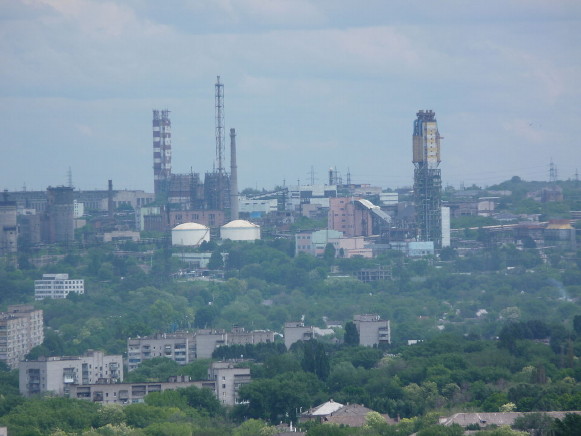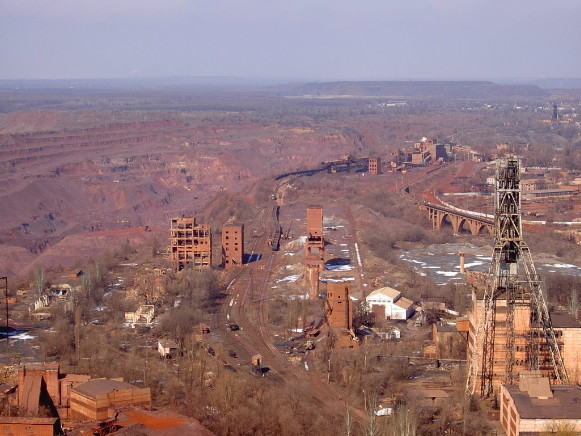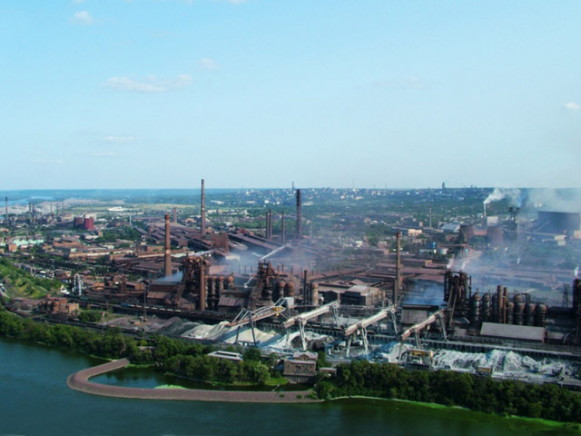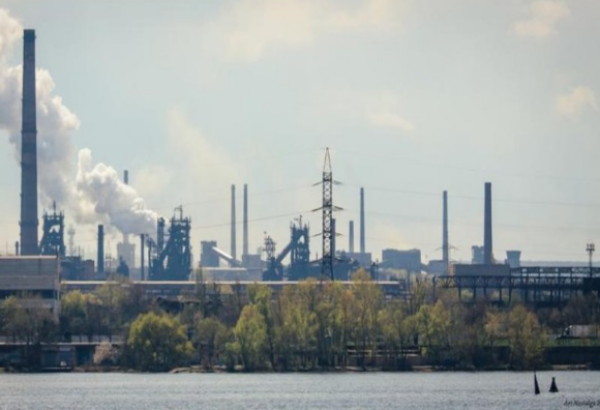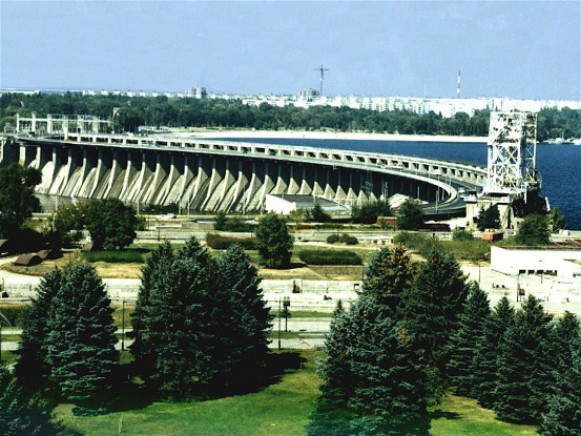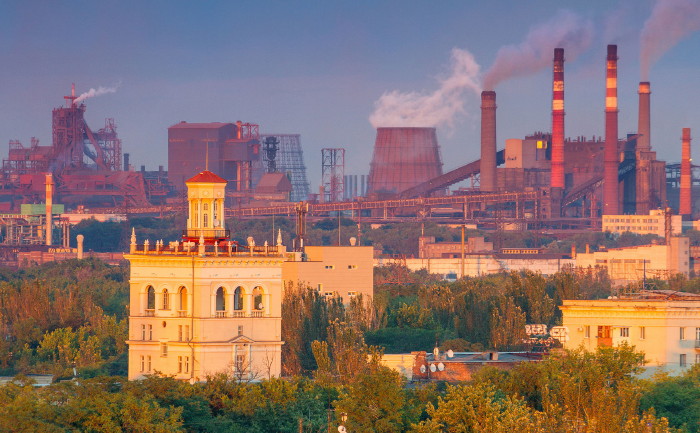Dnipro Industrial Region
Dnipro Industrial Region (also known as the Industrial Dnipro Region and in the late 1920s as Zaporizhia). After the Donets Basin (Donbas), the Dnipro Industrial Region is the second-largest concentration of heavy industry in Ukraine. It is located in the central part of the steppe (in Dnipropetrovsk oblast and Zaporizhia oblast, and part of Kirovohrad oblast and Poltava oblast), at the bend of the Dnipro River, and covers 16,900 sq km and has a population of about 3,250,000. The industry of the region is grouped into several heavily populated centers, which contain 90 percent of the region’s population. The population density in these centers is 600 per sq km, compared to barely 40 per sq km in the large agricultural areas separating them. The largest and most important center is the Dnipro Industrial Region proper, which consists of the city of Dnipro and its neighboring cities—Kamianske, Novomoskovsk, and Verkhnodniprovsk. Another center, the city of Zaporizhia and its suburbs, and the smallest center, Nikopol, lie on the Dnipro River.
The industrial development of the Dnipro region is the result of the mining of large deposits in the Kryvyi Rih Iron-ore Basin and the Nikopol Manganese Basin (and, partially, the Dnipro Lignite Coal Basin), the proximity of the Donets Basin and its huge deposits of coal, the region’s convenient geographical location at the intersection of north-south and east-west transportation routes, and the availability of industrial water, river transportation, and hydroelectric power from the Dnipro River (see Dnipro Cascade of Hydroelectric Stations). Among the natural resources of the region are building materials, refractory clays, and clayey soil. Lignite deposits at Verkhnodniprovsk have not been exploited as yet.
Development before 1914. Until 1880 the Dnipro Industrial Region and the rest of Katerynoslav gubernia, to which it belonged, formed an agricultural region. Its small towns—Katerynoslav (now Dnipro), Oleksandrivske (now Zaporizhia), and Novomoskovsk—were commercial-administrative centers. The development of the region was connected with the construction of a number of railway lines: Oleksandrivske–Moscow (1873), Oleksandrivske–Crimea (1875), and the Donetsk (1879), First Catherine (1884), and Second Catherine (1902) lines, which connected the Donets Basin with the Kryvyi Rih region and its iron ore.
At Katerynoslav and neighboring Kamianske, where the railway lines crossed the Dnipro River, metallurgy, using iron ore from Kryvyi Rih (120 km away) and coal from the Donbas (150 km away), sprang up. In 1887 the huge Alexander Metallurgical Plant of the Briansk Company (now the Dnipro Metallurgical Plant) began operating in Katerynoslav. In 1889 a pipe factory, then a steel plant and a wire and nail factory, were built. In 1887–9 the largest plant of the region—the Dnipro Metallurgical Plant (now the Dnipro Metallurgical Complex)—was constructed in Kamianske by the South Dnipro Metallurgical Company. Owing to its proximity to the large metallurgical plants of Katerynoslav and Kamianske, industry in Oleksandrivske also developed rapidly, and by the end of the 19th century Oleksandrivske had become the leading supplier of agricultural machinery in Ukraine.
On the eve of the First World War the Alexander and Dnipro plants produced together almost 830,000 tonnes of pig iron annually. This was 26.7 percent of Ukraine’s production (the Dnipro region produced 29 percent and the Donbas 58.7 percent) and 18 percent of the production in the Russian Empire. The Dnipro Industrial Region had the highest production of pig iron, steel, and rolled steel in the Russian Empire. Part of the region’s production was used domestically, but much of it was exported. The region’s metalworking industry (agricultural machinery in Katerynoslav and Oleksandrivske, etc), woodworking industry (using lumber from the upper Dnipro Basin), and food industry (mainly milling) were of lesser importance. Mining at Nikopol had a faster growth rate than did the entire metallurgy industry in Ukraine. On the eve of the First World War the Nikopol Manganese Basin extracted about one-fifth (90,000 tonnes in 1900, 276,000 tonnes in 1912) of the manganese in the Russian Empire.
1914-41. During the Revolution of 1917 the heavy industry of the Dnipro Industrial Region came to a standstill. The Petrovsky Plant (now Dnipro Metallurgical Plant) began operating again only in 1923. Then operations were gradually resumed at the plants in Kamianske, Zaporizhia, and Nikopol. In the 1930s the economic base of the region consisted of heavy industry. Besides iron ore mining and metallurgy, machine building grew rapidly. Manganese mining expanded greatly: in 1940, 1,000,000 tonnes of iron ore were extracted. The metallurgical industry expanded through reconstruction (the Petrovsky, Lenin, Liebknecht, and Comintern plants in Dnipropetrovsk, the Dzerzhinsky plant [now Dnipro Metallurgical Complex] in Dniprodzerzhynsk) and new construction in areas that previously had no metallurgy: Nikopol (See Nikopol Southern Pipe Plant), Novomoskovsk (a sheet-metal plant), and Zaporizhia (after Dnipropetrovsk, the next largest center of ferrous and non-ferrous metallurgy). In 1932–6 a number of metallurgical plants began operating in Zaporizhia: the Zaporizhia Dniprospetsstal Electro-metallurgical Plant, the Zaporizhstal ferrous metallurgy plant, the Dnipro Aluminum Plant, and a coke-chemical plant. Since 1932 the industry of the region has benefited from cheap electrical power provided by the Dnipro Hydroelectric Station (560,000 kW). In 1940 the region produced 2,072,00 t of pig iron (24.4 percent of the Ukrainian SSR’s total) and 3,024,000 tonnes of steel (35.1 percent of the Ukrainian SSR’s total).
Among the large plants constructed by 1941 were the following: the Krasin Automobile and Tractor Plant, a railway-signals plant, a transport-machinery plant, all in Dnipropetrovsk or Zaporizhia. Construction of an airplane plant was begun. The Artem Papermaking-Machinery Plant in Dnipropetrovsk, the Pravda Railway-Car Plant in Dniprodzerzhynsk, an airplane-engine plant, and the Komunar Agricultural-Machinery Plant (now Automobile Plant) in Zaporizhia were greatly expanded. Large repair plants for railway locomotives and railway cars were built. A large woodworking complex, Detalbud, which did some work for the military-defense industry, was opened. The armaments plant in Pavlohrad grew into the largest plant of its kind in the Ukrainian SSR. New chemical industries were set up in the region: carbonate, chemical, and oxygen plants in Zaporizhia, coke and nitrogen plants near Dniprodzerzhynsk. The food industry and light industry developed slowly. The need for more electric power led to the construction of thermoelectric stations in Dniprodzerzhynsk (96,000 kW) and Kryvyi Rih (120,000 kW).
After 1941. During the Second World War the Dnipro Industrial Region was devastated. Much of its machinery was transferred to the east; hardly any of it was returned after the war. Industrial reconstruction was completed in 1948–50. The Dzerzhinsky plant became the largest metallurgical plant in the region. Before the war it had produced over 1 million tonnes of pig iron a year; by 1949 its production exceeded this by 44 percent. It also produced 37 percent more steel than before the war. In 1947–9 the Zaporizhstal plant, the Dnipro Aluminum Plant (the only aluminum plant in the region), and the Dniprospetsstal plant were fully rebuilt. The magnesium plant in Zaporizhia was modernized, and it began to produce titanium alloys. In 1955, 2.4 times as much manganese concentrate was extracted from the Nikopol Manganese Basin as had been extracted in 1940. Agricultural-machine building expanded greatly, but light industry and the food industry continued to lag behind heavy industry and did not meet the needs of the population.
In the 1970s and 1980s no new metallurgical enterprises were created in the Dnipro Industrial Region, because of the Soviet policy of establishing heavy industry centers beyond the Urals. Ferrous and non- ferrous metallurgy were developed through the expansion of existing plants at the expense of modernization. But other branches of industry developed. These included machine building, energy, transportation, agriculture, factory construction, and passenger-automobile production (after 1959 the Zaporizhia Komunar Automobile Plant was producing the Zaporozhets car). A number of new plants producing various types of equipment and precision tools were established in Dnipropetrovsk, Zaporizhia, and Dniprodzerzhynsk in the 1960s. In Nikopol a ferrous-alloys plant and chemical plants were built. In the last two decades light industry, the food industry, and the construction industry grew rapidly. Their products satisfied not only local needs but were exported outside the region.
The energy supply of the region improved greatly with the discovery of natural gas at Pereshchepyne, the construction of the Pereshchepyne–Dnipropetrovsk (1966) and Shebelynka–Dnipropetrovsk (1957) gas pipelines (See Shebelynka Gas Industry Authority), the building of several electric-power stations (including the Dniprodzerzhynsk Hydroelectric Station and the Dnipro State Regional Electric Station), and the exploitation of coal gas.
Population. At the end of the 19th century (1897) the population of the Dnipro Industrial Region was about 700,000 (estimate), 27 percent of which (186,000) lived in towns such as Katerynoslav (120,000), Oleksandrivske (19,000), Nikopol (17,000), Kamianske (17,000), and Novomoskovsk (13,000). In the 1860s these towns had barely 40,000 inhabitants (12 percent of the region’s population). The population was 950,000 in 1914 (estimate), 1,100,000 in 1926, and 3,250,000 in 1978. Thus, in 52 years the population tripled. A comparison of the population in the region between 1926 and 1979 is given in table 1.
The most rapid population increase occurred in the 1930s. This is evident from the increase in the number of people in towns of over 50,000: 347,000 in 1926, 1,027,000 in 1939, 1,464,000 in 1959, 1,979,000 in 1970, and 2,373,000 in 1978. In 1926 31.8 percent of the population lived in these cities; in 1970, 70.7 percent did. The population increased most during the first three five-year plans (1927–39), when the average annual increase was 8 percent. It fell in the 1960s to 2.7 percent and in 1970–8 to 1.3 percent.
Since the end of the 19th century the region has had population influxes from other parts of Ukraine and Russia. After 1950 the population of the region increased more rapidly than that of the Donbas, and the populations of Dnipropetrovsk, Dniprodzerzhynsk, and Zaporizhia grew more rapidly than that of any other Ukrainian city except Kyiv.
The population is not evenly distributed throughout the region but is concentrated in the industrial centers. The population distribution in 1979 is given in table 2 (the 1926 figures are in parentheses).
The main cities in the Dnipro center are Dnipro (2018 pop 1,000,506), Kamianske (2018 pop 235,066), and Novomoskovsk (2015 pop 71,434). The Zaporizhia center has only one city, Zaporizhia (2016 pop 754,619). The Nikopol center embraces Nikopol (2018 pop 112,102), Marhanets (2016 pop 47,812), and Pokrov (2015 pop 40,857).
The changes in the populations of the largest cities between 1860 and 1979 are given in table 3.
National composition. Prior to industrialization, almost 90 percent of the region’s population consisted of Ukrainians, if one excludes the cities, particularly Katerynoslav, which had a mixed population of Ukrainians, Russians, Jews, and some Germans. Industrialization stimulated the in-migration of Russians: insignificant at first, it increased in the 1930s and continued to increase until the 1990s. During the First World War and the Revolution of 1917 the number of Germans decreased, and during the Second World War the Jewish population decreased. These changes are represented in table 4, which shows the national composition (based on estimates).
The national composition of the population of the major cities in 1926 and 1959 is given in table 5.
BIBLIOGRAPHY
Khyzhniak, A. Zaporiz'ka oblast' (Kyiv 1959)
Narodne hospodarstvo Dnipropetrovs'koï oblasti: Statystychnyi zbirnyk (Donetsk 1966)
Palamarchuk, M. Heohrafiia promyslovosti Ukraïns'koï RSR (Kyiv 1967)
Za porohamy Dniprovymy (Dnipropetrovsk 1967)
Tvii ridnyi krai (Dnipropetrovsk 1968)
Volodomyr Kubijovyč, A. Popliuiko
[This article originally appeared in the Encyclopedia of Ukraine, vol. 1 (1984).]
